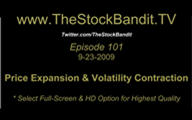High volatility in the market usually accompanies some rapid declines and sharp selloffs induced by panic. Traders sell abruptly and ask questions later, and when price begins to rebound there’s a collective worry of being left behind. That of course puts some urgency into the upside. The combination of these factors delivers some pretty lively trading conditions, and there’s never a dull moment.
The flip side of the coin can be the bull market where the buyers step in to provide support on every dip until it stops working. The declines are shallow and temporary, and the advances tend to be somewhat quiet. As a result, bull markets can bring lower volatility.
But there’s one point worth noting, which is that as prices climb, the trading range naturally has a wider zone to fluctuate within. So when we see the market make a huge move to the upside over the past few months but with very narrow day-to-day fluctuations, it still requires some adjustments.
Here in Episode 101, I’m going to show you what I’m talking about and share with you a discovery I made which is going to translate into a slightly different approach for some of you. I hope you find it helpful!
(Be sure to click the full-screen option for best viewing.)
Hope you enjoy the show! Thanks for watching and subscribing, and feel free to post your ideas and comments down below.
Trade like a Bandit!
Jeff White
President, TheStockBandit, Inc.
www.TheStockBandit.com (Premium service)
www.TheStockBandit.net (Trading Blog)



















August 24th, 2010 at 10:48 am
[...] market. I just put out a post explaining how and when to use moving averages. I will sometimes add ATR to my chart to see just how much (or how little) movement there’s been lately, and that’s another [...]